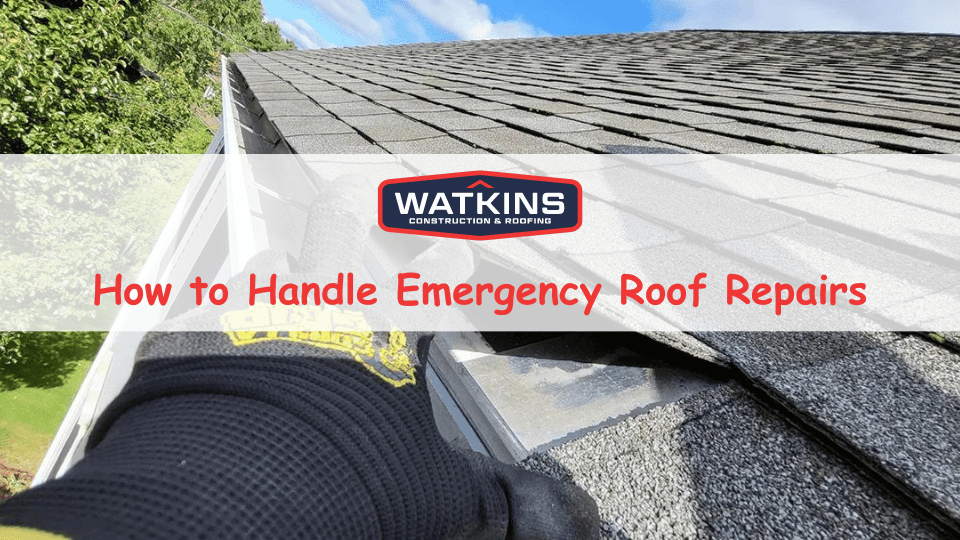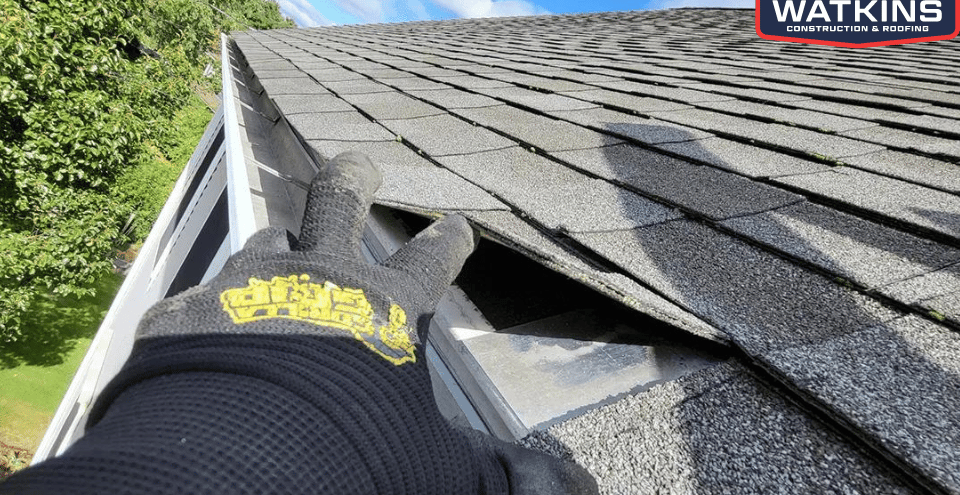How to Handle Emergency Roof Repairs with Watkins Construction & Roofing. Your roof is your home’s first line of defense against the elements, and sometimes it can face unexpected challenges like severe storms, fallen trees, or sudden leaks. When a roofing emergency occurs, knowing how to handle it promptly and effectively can make a significant difference in minimizing damage and ensuring your family’s safety. In this comprehensive guide, we’ll provide you with the essential steps and tips on how to handle emergency roof repairs.

Safety First:
Before you begin any emergency roof repair, prioritize safety for yourself and others in your home:
Stay Calm: A calm approach is crucial. Panicking can lead to accidents and mistakes.
Assess the Situation: Determine the severity of the damage and whether it’s safe to remain inside your home. If the damage is extensive or poses immediate risks, evacuate and call emergency services.
Turn Off Power: If you have water leaking near electrical fixtures or wiring, turn off the power to the affected area to prevent electrical hazards.
Use Caution: When inspecting your roof or attempting temporary repairs, always use proper safety equipment, including a harness, safety lines, and sturdy footwear.
Temporary Roof Repairs:
Temporary roof repairs are designed to stop further damage until a professional can assess and fully repair your roof. Here are the steps for handling common roofing emergencies:
Leaking Roof:
Contain the Water: Place buckets, pots, or towels under the leak to catch and divert the water away from your home’s interior.
Clear the Area: Remove furniture, electronics, and valuables from the affected area to prevent damage.
Inspect the Attic: If safe, check your attic for signs of leaks or water damage. You can often pinpoint the source of the leak from inside.
Patch the Leak: Depending on the severity of the leak, use materials like roofing tar, roofing cement, or a tarp to cover the damaged area temporarily. Be cautious when climbing on your roof and follow safety guidelines.
Missing or Damaged Shingles:
Secure Loose Shingles: If you have loose or missing shingles, use roofing nails to secure them back in place temporarily.
Replace Missing Shingles: If shingles are missing or damaged beyond repair, use a piece of plywood covered with roofing felt or a tarp as a temporary cover until you can install new shingles.
Holes or Punctures:
Patch the Hole: For small holes or punctures, apply roofing cement or a roofing patch kit to seal the damaged area temporarily.
Use a Tarp: For larger holes, secure a tarp over the damaged section using furring strips or boards to hold it in place.
Gutter Damage:
Clear Debris: If your gutters are damaged and causing water to overflow, clear any debris from the gutters and downspouts to facilitate drainage.
Temporary Repair: Use roofing cement to seal minor gutter cracks or holes temporarily.
When to Call a Professional:
While temporary repairs can help mitigate immediate damage, it’s essential to consult a professional roofing contractor for a thorough assessment and permanent repairs. Here are some situations when you should contact a roofing professional:
Severe Damage: If your roof has suffered extensive damage from a storm, fallen tree, or structural issue, do not attempt to repair it yourself. A professional can assess the extent of the damage and provide the necessary repairs.
Leaks Persist: If temporary measures do not stop the leaks, or if the leaks worsen, it’s time to call a professional. Persistent leaks may indicate underlying issues that require expert attention.
Safety Concerns: If you feel unsafe or uncomfortable performing repairs on your roof, it’s best to leave it to professionals who have the necessary training and equipment.
Insurance Claims: If the damage is severe and you plan to file an insurance claim, a professional assessment and documentation of the damage are essential for the claims process.
Preventing Future Roof Emergencies:
Once your emergency roof repair is complete, take steps to prevent future emergencies:
Regular Inspections: Schedule routine roof inspections, ideally at least once a year, to identify potential issues before they become emergencies.
Trim Trees: Keep trees near your home trimmed to prevent branches from falling and damaging your roof during storms.
Clean Gutters: Regularly clean and maintain your gutters and downspouts to prevent clogs and water buildup.
Secure Loose Shingles: If you notice loose shingles during inspections, secure them promptly to prevent future damage.
Roof Maintenance: Invest in proper roof maintenance, including sealing seams and flashing, to extend your roof’s lifespan.
Professional Roofing Contractor: Establish a relationship with a reputable roofing contractor who can provide regular maintenance and respond quickly in case of emergencies.
Conclusion:
Handling emergency roof repairs requires a calm and cautious approach to ensure your safety and minimize damage to your home. While temporary fixes can provide immediate relief, it’s essential to consult with a professional roofing contractor for a thorough assessment and permanent repairs. Additionally, preventive measures such as regular inspections and maintenance can help reduce the likelihood of future roof emergencies, giving you peace of mind and protecting your home from unexpected roofing challenges.
For more information, you can reach Watkins Construction & Roofing at 601-488-3179. We service areas in Jackson, Flowood, Clinton, and Ridgeland, MS.
